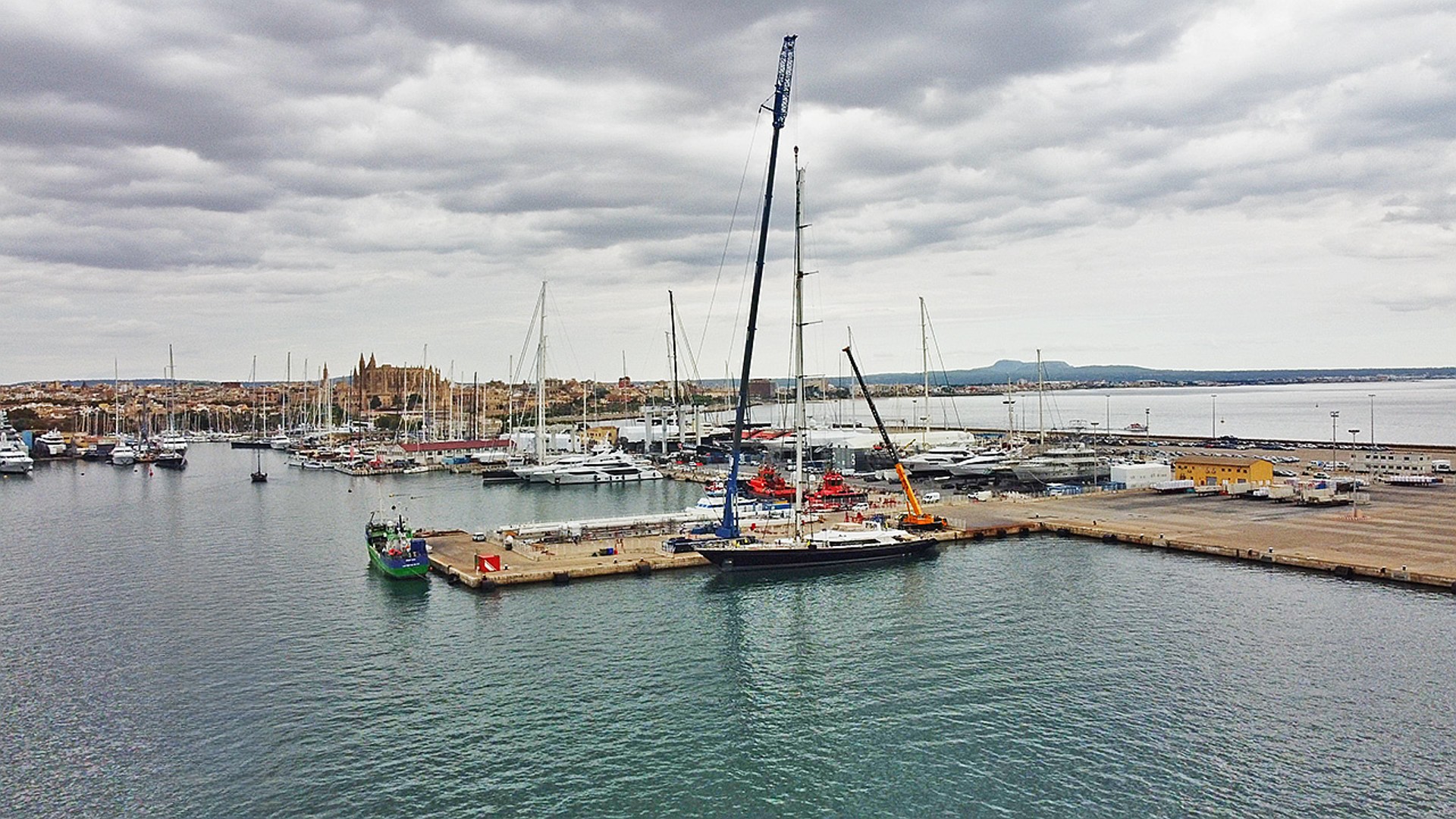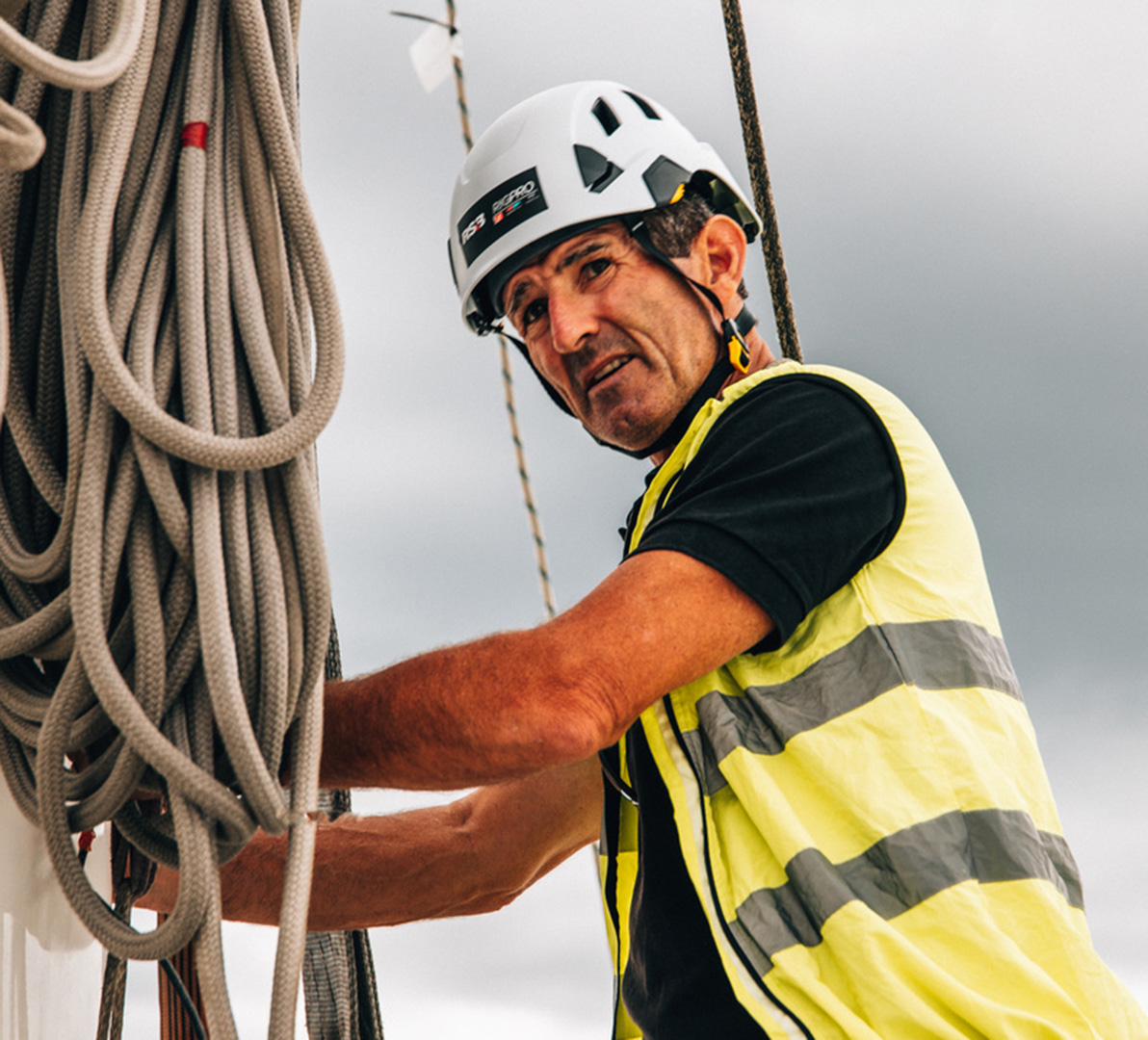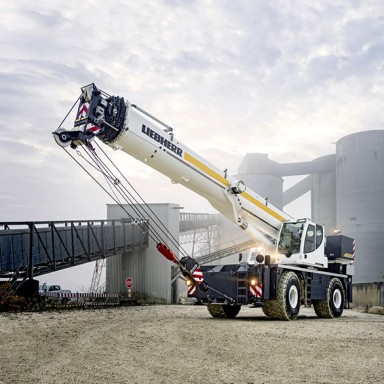
October 2023
At the harbour's edge
Dawn is breaking over the islandʼs sleepy capital. Itʼs still quiet in Palma de Mallorca – only in the harbour are great things on the horizon. The metal loading flap of the ferry jetty rests against the quay walls with a creaking, clattering sound. The beeping and flashing of forklifts shatter the early morning calm. And then the moment arrives – a blue LTM 1650-8.1 rolls off the deck.

Highly fragile load for the ultimate machine on eight axles
The Liebherr mobile crane was brought from the Spanish mainland to the Mediterranean island last September for a special job. In the harbour of Palma de Mallorca, it was tasked with lifting out the 72 metre long, 24 tonne aluminium rigging of a super yacht. The lift was coordinated by the traditional Mallorcan company Grúas Pol in collaboration with Grúas Leman and the rigging company RSB Rigging Solutions. No easy undertaking, because the enormous rig not only includes the boom but also wiring looms, a multitude of ropes and “standing rigging”, i.e. large diameter, solid stainless-steel rods that hold the mast upright and in position. “During regular maintenance and inspection periods, we lift the mast out of the vessel, put it down, dismantle everything and carry out the maintenance and service work. We then reassemble all the components, so the yacht is ready for use again,” explains Steven Branagh, owner of RSB Rigging Solutions.
When we lift the mast out of the vessel it becomes quite unstable and moves a lot from side to side, so we have to pay additional attention to the wind conditions during the whole process.
Sure instincts and low wind
The fact that this maintenance work is such a delicate affair is not only due to the fact that a mast of this size costs between five and six million euros but multiple factors that can affect the task at hand: “When we lift the mast out of the vessel it becomes quite unstable and moves a lot from side to side, so we have to pay additional attention to the wind conditions during the whole process,” Branagh continues. “Since the mast is delicate, you also need a lot of finesse,” adds crane driver Pedro García Salas. Many hours of planning and preparation go into a job of this kind. Accordingly, six riggers spent about ten days preparing the rigging for the lift for this project to help ensure a flawless unstepping of the rig. In addition, each professional involved in the project, from the riggers to the operational team, come together to create the conditions for the most seamless rig movement possible: “The last thing we need here is a crane that is rusty or looks poorly maintained. So, I was very happy when I saw a brand new Liebherr crane from Grúas Leman on the quay and knew it would make our work much easier,” Branagh adds. The 700 tonner was shipped specially from the mainland to the Balearic Island for operational reasons. The yacht client wanted to have his yacht serviced by RSB Rigging Solutions but the largest crane available on Mallorca did not have sufficient lifting capacity for this job. Therefore, Grúas Pol arranged for the Liebherr LTM 1650-8.1 at Grúas Leman to be shipped from the Spanish mainland.
By clicking on “ACCEPT”, you consent to the data transmission to Google for this video pursuant to Art. 6 para. 1 point a GDPR. If you do not want to consent to each YouTube video individually in the future and want to be able to load them without this blocker, you can also select “Always accept YouTube videos” and thus also consent to the respectively associated data transmissions to Google for all other YouTube videos that you will access on our website in the future.
You can withdraw given consents at any time with effect for the future and thus prevent the further transmission of your data by deselecting the respective service under “Miscellaneous services (optional)” in the settings (later also accessible via the “Privacy Settings” in the footer of our website).
For further information, please refer to our Data Protection Declaration and the Google Privacy Policy.*Google Ireland Limited, Gordon House, Barrow Street, Dublin 4, Ireland; parent company: Google LLC, 1600 Amphitheatre Parkway, Mountain View, CA 94043, USA** Note: The data transfer to the USA associated with the data transmission to Google takes place on the basis of the European Commission’s adequacy decision of 10 July 2023 (EU-U.S. Data Privacy Framework).From the vertical to the horizontal
How does this unstable mast get from the crane hook to lying horizontally in the support towers in the shipyard? This equally delicate process requires a second crane whose hook is attached to the lower end of the aluminium mast after being lifted from the yacht and stabilised. For this project, the local transport service provider used an LTM 1200-5.1 from its own fleet: “In tandem, the two cranes bring the rigging into a horizontal position,” explains Ed Juárez, the project manager at Grúas Pol. “The crane drivers then carefully manoeuvre the mast onto transport trestles allowing the rigging team and other contractors to work on it easily.” A sailing rig of this size usually spends twelve to 18 weeks in the yard while undergoing maintenance. This includes, among other things, cleaning the mast, servicing, and checking the fittings and painting works if required. Once the riggers have completed all maintenance, they reassemble the rigging and – just as carefully – reinstall it back onboard the yacht.




